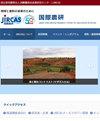坡耕地肉牛放牧场地及粪便的空间分布特征
IF 0.5
4区 农林科学
Q4 AGRICULTURE, MULTIDISCIPLINARY
引用次数: 1
摘要
牲畜在草场中选择能提供高质量和营养的草的地方,而这些选择导致了空间异质性和生产力的降低。为了最大限度地提高放牧系统的效率,了解牲畜放牧行为的时空信息非常重要。在这篇综述中,我们描述了开发一个简单的工具来确定牛的觅食行为,并预测牛粪便在陡坡牧场的空间分布的研究。使用基于加速度计的活动监测器Kenz Lifecorder EX(以下简称LC)来区分肉牛的觅食和其他活动。线性判别分析对LC的分钟数据具有良好的判别精度。将活动时间线与GPS跟踪数据相结合,成功地揭示了倾斜牧场奶牛觅食活动的时空分布。牧草的觅食活动和排泄在牧草的养分循环中起着重要的作用。我们发现牛粪的空间分布可以使用贝叶斯方法与广义线性混合模型相结合来预测,该模型包含两个参数(绿色牧草生物量和距离水槽的距离)的条件自回归项。粪便沉积物倾向于分布在绿色牧草生物量较高的地区和靠近水槽的地区。本文还介绍了一种利用无人机图像检测牧场牛粪和杂草位置的牧场调查新方法。附加关键词:加速度计,牛,粪,无人机本文章由计算机程序翻译,如有差异,请以英文原文为准。
Spatial Distribution of Grazing Sites and Dung of Beef Cows in a Sloping Pasture
Livestock select places in a pasture that offer high-quality and nutritious grass, and these selections cause spatial heterogeneity and reduced productivity. To maximize the efficiency of pasture systems, it is important to understand the spatiotemporal information regarding livestock grazing behavior. In this review, we describe studies conducted to develop a simple tool for determining cow foraging behavior, and to predict the spatial distribution of cow excrement (dung) in a steeply sloping pasture. An accelerometry-based activity monitor, the Kenz Lifecorder EX (hereafter, the LC), was used to differentiate between foraging and other activities of beef cows. A linear discriminant analysis yielded good discrimination accuracy of the minute-based data of the LC. The combination of the activity timeline and GPS tracking data successfully revealed the spatiotemporal distribution of cow foraging activity in a sloping pasture. Both foraging activity and excretion play important roles in the nutrient cycling in pasture ecosystems. We found that the spatial distribution of cow dung could be predicted using a Bayesian approach in conjunction with a generalized linear mixed model incorporating conditional autoregressive terms with two parameters (green herbage biomass and distance from a water trough). Dung deposits tended to be distributed in areas with higher green herbage biomass and in areas located closer to the water trough. We also describe a new pasture survey method of detecting cow dung and weed positions in a pasture by using unmanned aerial vehicle (UAV)-based imagery. Discipline: Animal Science Additional key words: accelerometer, cattle, dung, UAV
求助全文
通过发布文献求助,成功后即可免费获取论文全文。
去求助
来源期刊
CiteScore
1.00
自引率
25.00%
发文量
42
审稿时长
>36 weeks
期刊介绍:
The Japan Agricultural Research Quarterly (JARQ) is a publication of the Japan International Research Center for Agricultural Sciences (JIRCAS), which provides readers overseas with the latest information on key achievements and developments in agricultural research in Japan, with the expectation that this information would contribute to the agricultural development of countries in tropical and subtropical regions.

 求助内容:
求助内容: 应助结果提醒方式:
应助结果提醒方式:


